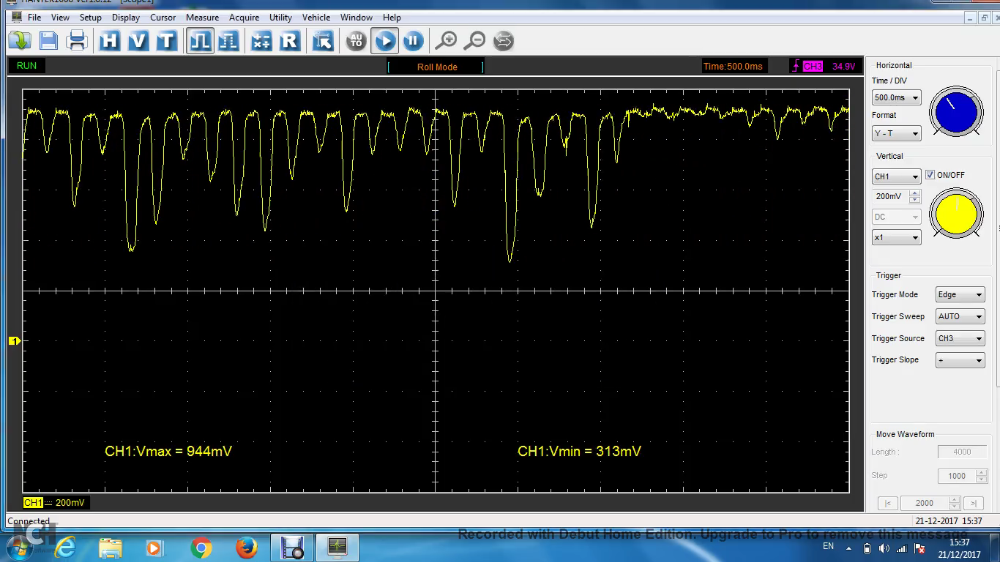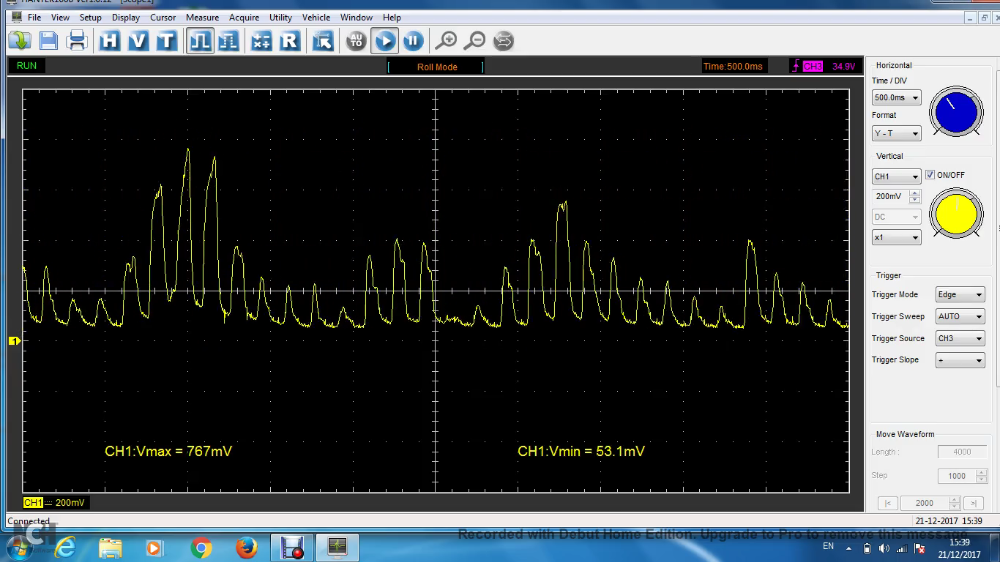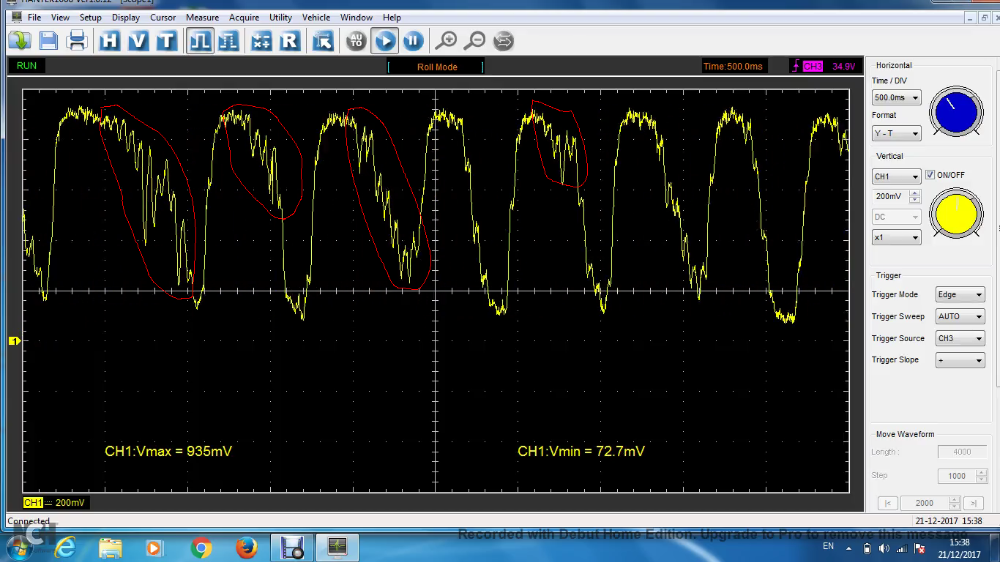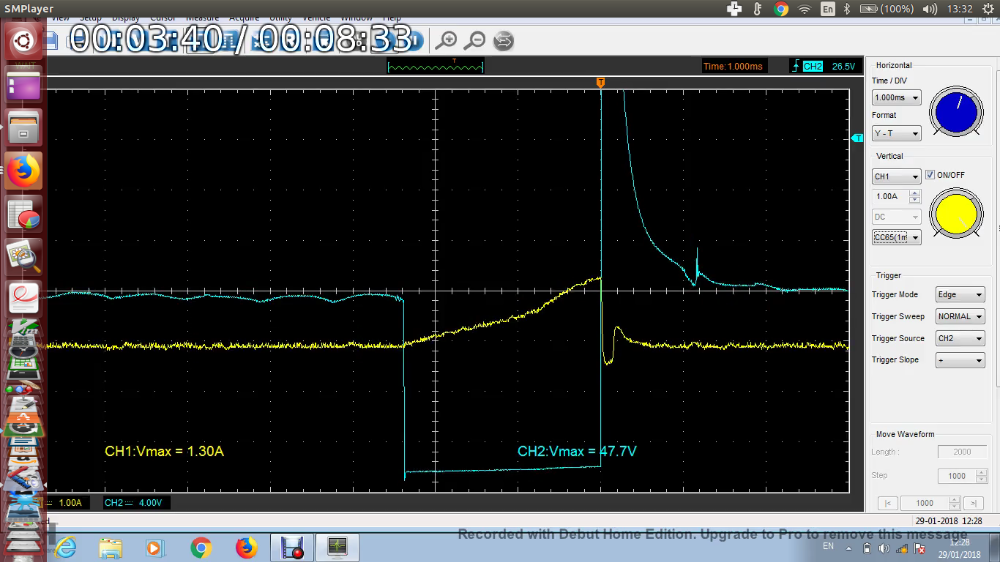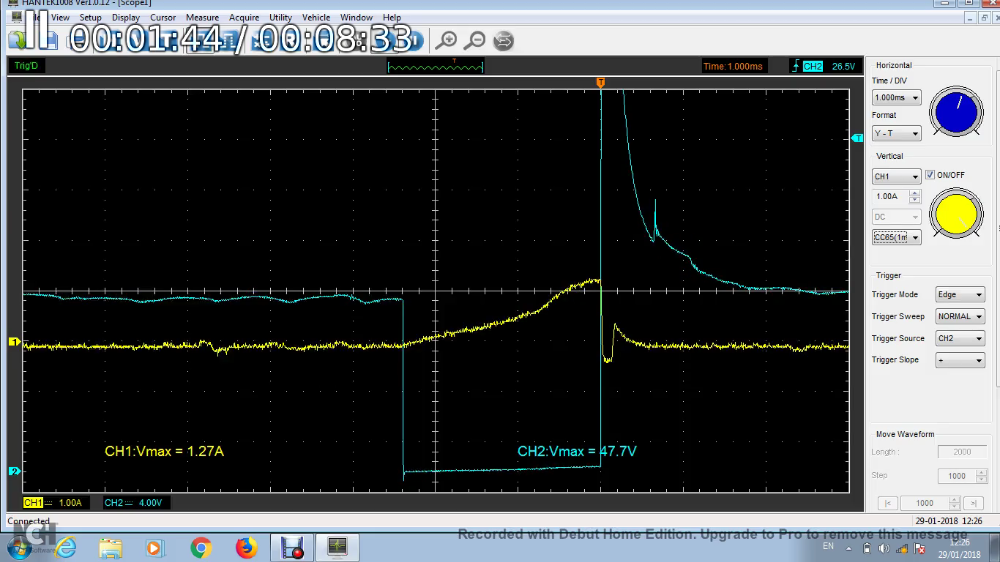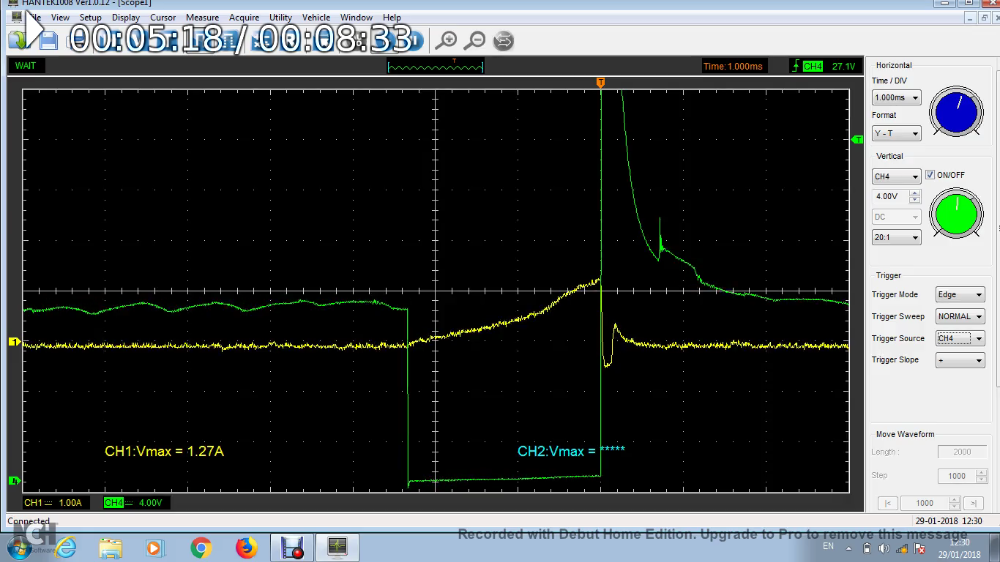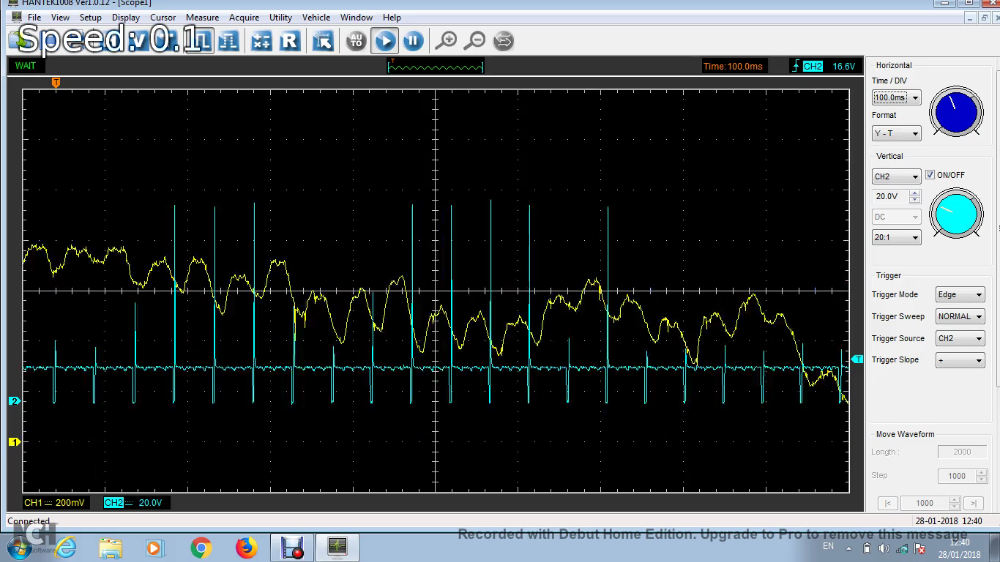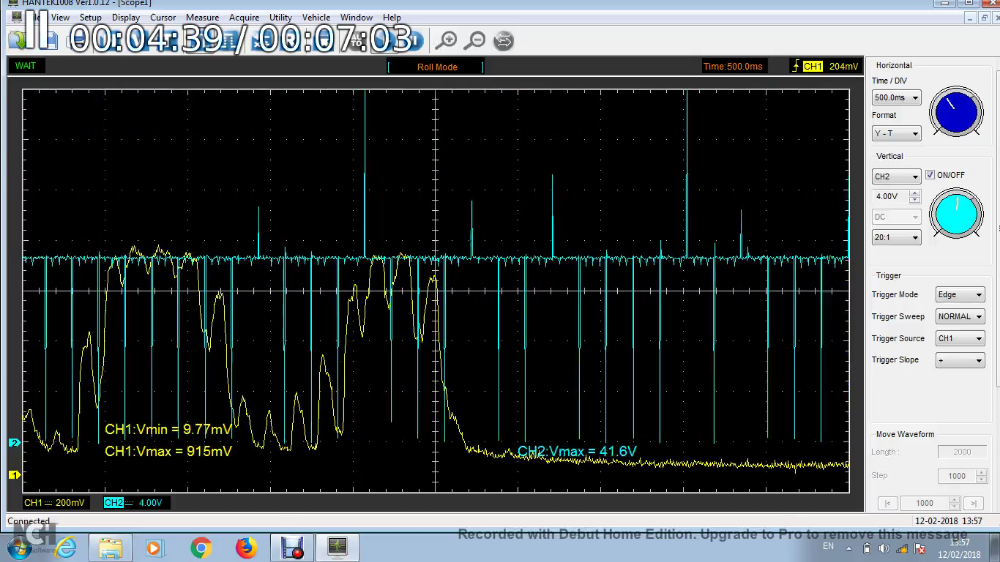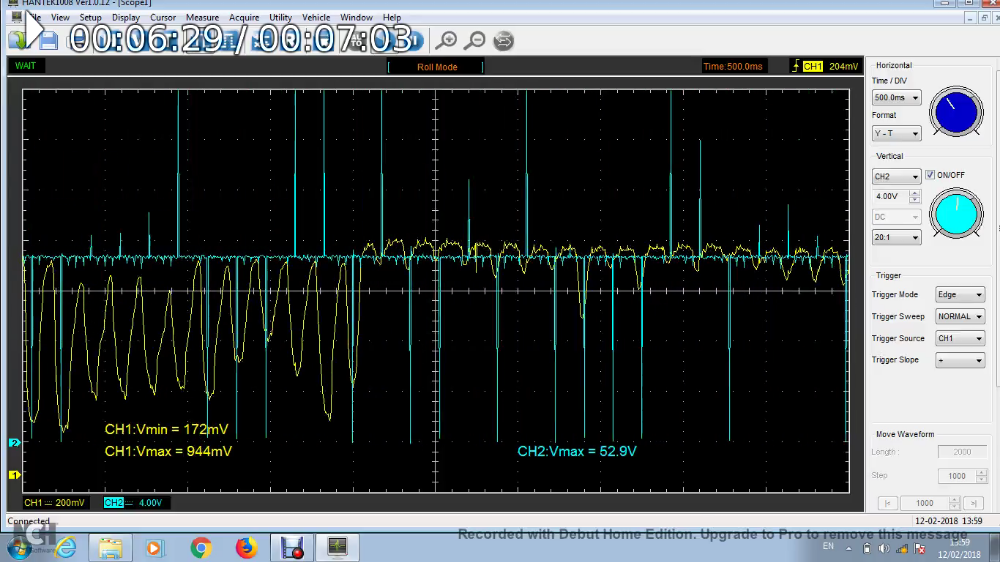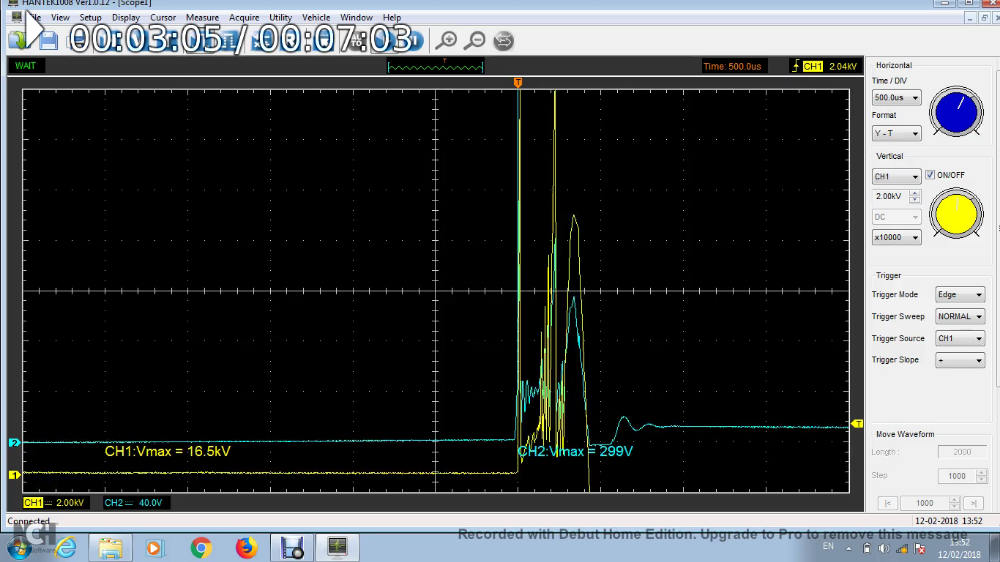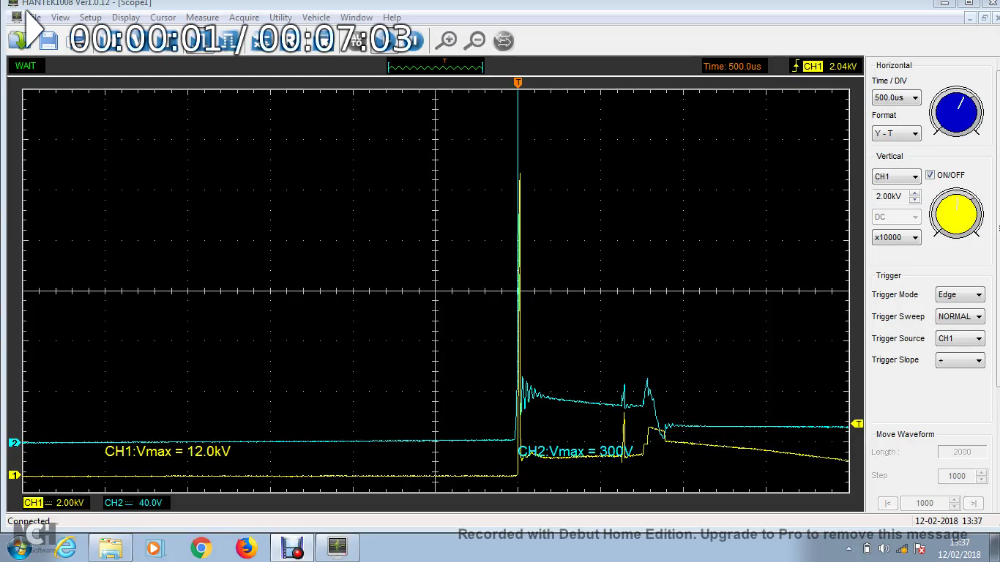poor Fuel Efficiency, strange O2 waveforms and injector opening time
- SailorBob
-
 Topic Author
Topic Author
- Offline
- Elite Member
-

Symptoms:
Mild misfiring for the first few minutes after startup on cold days
Inconsistent fuel efficiency
Intermittent poor idle speed and quality
Brand new OE O2 Sensor
O2 signal usually pegged low, but will get pegged rich or lean with fast oscillations after revving the engine for a few seconds. Also shows fast oscillations in the larger fuel control waveform when revving engine.
5 Second Screen, 200mV / div
Pegged high
Pegged low
A short ( 1:40 ) video capture of the problem:
I scoped the injectors and two injectors ( #2 & #4 ) showed the following pattern with the pintle always closing exactly 1ms after voltage shutoff:
The #1 injector always shows pintle close at 1.1ms after voltage shutoff:
The #3 injector always shows pintle close at 1.2ms after voltage shutoff:
So I'm fairly new at this and am wondering if such small differences are significant and definitively the source of the problem?
The firing order is 1-3-4-2 and one can see that the dips in the O2 signal seem to correspond to when the 1 and 3 injectors are firing:
If this is the problem and if these are just sticking injectors, could running something like high concentration Seafoam through the system solve the problem, or would new / rebuilt injectors be the only option?
Please Log in or Create an account to join the conversation.
- SailorBob
-
 Topic Author
Topic Author
- Offline
- Elite Member
-

Attachment not found
Please Log in or Create an account to join the conversation.
- chief eaglebear
-
- Offline
- Platinum Member
-

- Posts: 329
- Thank you received: 70
Please Log in or Create an account to join the conversation.
- rockp2
-

- Offline
- Elite Member
-

- Posts: 167
- Thank you received: 40

Please Log in or Create an account to join the conversation.
- SailorBob
-
 Topic Author
Topic Author
- Offline
- Elite Member
-

www.amazon.com/gp/product/B077N76B2Z/ref...A1R0JBJ46WBNT5&psc=1
Thanks!
Please Log in or Create an account to join the conversation.
- kostelectronics
-
- Offline
- Senior Member
-

- Posts: 57
- Thank you received: 7
BR Matthias
Please Log in or Create an account to join the conversation.
- SailorBob
-
 Topic Author
Topic Author
- Offline
- Elite Member
-

Please Log in or Create an account to join the conversation.
- graywave
-

- Offline
- Elite Member
-

- Adv. Diagnostics New Hampshire
- Posts: 302
- Thank you received: 80
Guessing this was the upstream O2? When its pegged lean you should see down stream lean out some too. Just a way to confirm the o2 is reading correctly
What are your Short and Long term fuel trims doing while its pegged rich and what do they do when its pegged lean?
If you ever see short and long term fuel trim conflict each other (Ex. LT is far positive and ST is far negative) then you could say you have an intermittent vacuum leak. I've seen that before.
Confirm what it's not, and fix what it is!
Please Log in or Create an account to join the conversation.
- Tyler
-

- Offline
- Moderator
-

- Full time HACK since 2012
- Posts: 6059
- Thank you received: 1530
Please Log in or Create an account to join the conversation.
- SailorBob
-
 Topic Author
Topic Author
- Offline
- Elite Member
-

Please Log in or Create an account to join the conversation.
- SailorBob
-
 Topic Author
Topic Author
- Offline
- Elite Member
-

I looked for more vacuum leaks with my, "blow cigar smoke into the brake booster hose" method, but couldn't see any - although that doesn't mean there isn't.
It's an OBDI vehicle, so no FT data available, and no post-Cat O2. Just something called "A/F Alpha" which is has been between 93-97% at idle when I've looked at it and goes up to 101% initially when revving the engine but then falls again. The thing is I've been having trouble connecting to the ECU intermittently.
So what's happening now is I'm seeing a mixture of patterns on the O2, pegged rich, pegged lean and misfire hacksaw. Sometimes it switches from one to another after revving the engine, sometimes it switches on it's own for no apparent reason. I captured some of this delicious wackyness on video here right after doing some throttle snaps on each cylinder at about 4 minutes in:
Here are two example of what I'm talking about, it just switching between states on it's own.
From hacksaw to lean:
From hacksaw to rich:
As I mentioned, I did throttle snaps on each cylinder. Initial sparks get up to about 24kV and 0.5ms burn time and around the 5-6th spark of the snap each cylinder has what looks like a lean misfire to me; something like this:
So whatever the problem is affects all four cylinders it seems like. I also noticed the current ramp varied from about 7.24 - 7.7 amps.
One other thing that I saw which was strange, where spikes like this in each cylinder's burn line at idle:
I happened to see this case study by John Thornton in which he says something like this indicates a mechanical problem; in his vid it turns out to be a cam sprocket that's not lined up properly with the cams:
I wonder if this kind of thing could also be caused by slack in a timing chain?
So to recap, 98 Nissan Almera 1.6L GA16DE DOHC engine, 358k kilometers, OBDI vehicle getting maybe 10-15% less fuel efficiency than it should, which has hard misfires upon hard acceleration on cold days during the first five minutes of operation, but only on the first startup of the day. Once warmed up it has an inconsistent idle which is sometime slightly high and sometime slightly low and mildly rough.
Original cap and rotor, which don't seal that well, but which can't be replaced without replacing the entire distributor, which would have to be imported from overseas. New plugs, new O2. Idle air screw had been opened a little in the past to compensate for stalling when coming to a stop.
Regarding the cold days problem, my guesses would be either condensation getting into the dizzy cap overnight, which burns off after the first few minutes of operation, or an intake manifold leak which seals up when the engine is above a certain fairly low temperature, since the problem only occurs on fairly cold mornings.
Whether the cold day startup issues are related to the fuel efficiency and weird O2 patterns I couldn't say.
The alternator also seems to be putting out an excessive amount of AC voltage and amperage at the alternator post ( 300mv, 7amps at idle with no electrical loads ) which can be seen here:
So the big question now is how to proceed in my diagnosis?
Please Log in or Create an account to join the conversation.
- Tyler
-

- Offline
- Moderator
-

- Full time HACK since 2012
- Posts: 6059
- Thank you received: 1530
SailorBob wrote: Thanks! Has the underlying problem posting images been solved?
I actually had no trouble uploading them as is? *shrug* I do know that the forum software sometimes gets pissy when adding too many images in one post. The fix is to post one or two images first, and edit the rest in later.
Please Log in or Create an account to join the conversation.
- SailorBob
-
 Topic Author
Topic Author
- Offline
- Elite Member
-

Please Log in or Create an account to join the conversation.
- SailorBob
-
 Topic Author
Topic Author
- Offline
- Elite Member
-

Results are that a flow test now shows two injectors dropping 11psi, while the other two drop 12psi on a 100 3.5ms pulses, and 9psi and 10psi on 50 7ms pulses, respectively.
In the first case the difference is 9% and the second 11%, taking the lower number as the baseline. Surprisingly, it's the two injectors with the higher flow that seem to have the intermittent misfires and shorter ignition burn lines.
New injectors are $75 a pop plus international shipping and customs duties, so I'm going to see about grabbing one or two from a junk yard and seeing if I can flow match any of the current injectors.
What really surprises me though is that a one psi difference could cause such noticeable performance issues since I've always heard that up to a 1.5 psi difference is considered acceptable.
Please Log in or Create an account to join the conversation.

